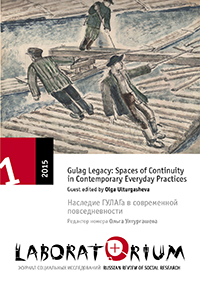The Communal Apartment under “Special Surveillance”: The Legacy of the Soviet Gulag in Multiethnic Criminal Subcultures in Eastern Siberian Prison Camps
Main Article Content
Abstract
This article explores modern Siberian discursive practices of interethnic divisions among prisoners, which are still based on the Soviet model of a multiethnic prisoner population. The contemporary Russian xenophobic image of the organized and anonymous mass of newcomers from Central Asia and the Caucasus clearly contrasts with the ethnic-difference-sensitive perception of “non-Russians” in Siberian prison camps. The effectiveness of forced nonethnic consensus is based on a well-established hierarchical code according to which all prisoners are expected to subordinate themselves regardless of their ethnicity. It is genealogically linked to the sociality established during the Gulag era and is entangled with a “cosmopolitan” Soviet ethnic policy. The comparative analysis of prisoners’ discourses on Eastern migrants offers an opportunity to identify traces of Soviet nationality policy as well as prisoners’ sociality in the Soviet Gulag camps in modern Russian criminal culture. This analysis is based on the author’s field research conducted in Eastern Siberia in 2012–2014. In English, extended summary in Russian.
Keywords
Siberia, Siberian Prison Camps, Multiethnic Relationships, Gulag Legacy
Abstract 171 | PDF FULL PAPER Downloads 127 PDF EXTENDED SUMMARY (Русский) Downloads 74 HTML FULL PAPER Downloads 128 HTML EXTENDED SUMMARY (Русский) Downloads 12

